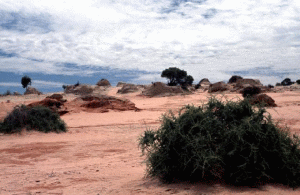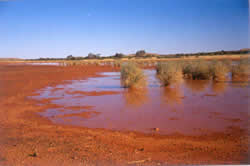The Road to Lake Mungo
Adventure or Nightmare?
Because of the urgent need for John, my husband, to make a trip to South Australia from New South Wales, and the difficulty in connecting air flights at such a short notice, John decided we would drive and make the journey a bit of a holiday as well.

We drove steadily, sharing the driving, along the main Sydney to Melbourne highway, turning onto the Sturt Highway towards Wagga Wagga and spent the night at Hay. In the morning we set off early to continue driving on our way to Berri in the Riverland district north of South Australia, where John was to have his urgent meeting.
On the way we passed through Balranald and noticed signposts to Mungo National Park 150 kms inland. With a little persuasion from me,(upstairs was prompting me to go) John agreed it would make an interesting visit and agreed we should investigate the possibility of travelling there upon our return from Adelaide where he was to have another business meeting.
Mungo National Park is an ancient Lakes area, now arid desert. It is were the Mungo Man was discovered dating back 62,000 years and other evidence of life and living by the early indigenous people of the once verdent country. Geologists, archaeologists and paleontologists are able to read the area as if it is an ancient history book. It is for this reason I was so interested in visiting the area.
When we left Adelaide and reached Mildura we found signs to the National Park advising the distance to travel was 110 kms, mostly dirt road and we could pick up the 150 kms on to Balranald, also mostly dirt road but we would be further along the Sturt Highway on our way home. At Mildura we visited the large and impressive information centre to find out what we should do to make the trip. We were advised that the road was good, although mostly dirt and we would be able to make the journey in our sedan car. We should take plenty of water and food and make sure we had a full tank of petrol. There would be no mobile telephone connection along the way.
We set off at 6am the next morning, for some reason feeling nervous. The road signs advised the roads were open. It had been hot when we had passed through the town on the way down to Adelaide, in fact drought had been experienced for the past seven years and the townsfolk were allowed to only water their gardens once per week. The farmers and pastoralists were only allowing the most profitable fruit trees and pastures to receive allotted water from the drought stricken riverlands. Most farmers were hurting severely and could no longer afford to buy extra water to keep all their crops alive.
So it was a surprise to us that it began to sprinkle rain half way into the desert lands.
The lands being so dry we could see the rain disappearing into the very dry road. It was a good road with no pits or bumps. Cattle from time to time ran across in front of us, and so did sheep – houses had long been left behind. We had driven for 1 and half hours with out passing a soul and now we were into very flat and vast desert as far as the eye could see, with only tiny salt bush and red earth. We seemed to have even left the kangaroos and emus behind.
One sign said we were entering Willandra Lakes, the ancient lakes of which Mungo National Park was a part. We began to worry and even though the rain was falling lightly we decided to push on to hopefully find people stationed at Mungo Park. At least it was cool for we had expected an extra hot day.
Not a good idea, for traveling at about 80 kms per hour we suddenly began to fishtail and then slide sideways for quite a way. John had military training in such a situation and we didn’t flip over but we did stop quickly, ploughing into soft sand. When we climbed out of the car we found the ground was a thin layer of wet red clay and under it was still dry fine red sand. While in the car, the road had looked no different from what we had been driving on for the past 100 kms. We had trouble standing up for we began to slip and slide around on the slick damp surface. Our shoes were immediately covered in thick mud so that we looked like we were walking around on clay plates.

It was impossible to keep the red clay mud out of the car, not that that was the main problem. John managed to dig us out and we drove for another 100 metres and bogged again. Now we were in real trouble. – In the middle of nowhere and not being able to move forward or go backwards. The spinning wheels only dug us deeper into the mud and dry sand. The rain was now falling heavier. We were nervous and feeling fear, not a normal reaction for us. We could be stuck out here for days before someone came by. And what if the rain became even heavier? Where we were, could become a quagmire – our car could even begin to sink if it became too wet.
This was dangerous – what on earth were we to do. We are in our seventies with grey hair and even though John is English and not used to outback Australia, I was born Australian and well new of the dangers of being stranded in the desert, particulary in the hot summer. How could we have been so naive, and yet we had done all the right things to make the journey. I had visions of the newspapers carrying the story of some silly old couple who had ventured into the desert being ill equipped in a sedan car and not being found for days.
There is a God! For when I prayed for help in less than ten minutes there were 4 vehicles at the scene and nine people. In the distance I could see a white mini-bus coming from Mungo. John managed to walk towards them and hailed them to a stop. They then bogged also. Although I like to think it was right they were stopped or they may have slid and even tipped over. They were German tourists who had camped at Mungo Park the night before. They wanted to watch the beautiful and eerie sunset known for the area but they had to run for cover when a bad sand storm blew in and no one could see anything. We were told, heavy rain had begun about 2am in the morning and then had eased.
The next vehicle to arrive was a red 4 wheel truck that did not hesitate to pull out the mini bus. It was groaning and slipping all over but managed to pull the bus to firmer ground about 20 kms down the road. Then another whitish 4 wheel truck came from Mungo and began to try to assist us. Fortunately for us they were plumbers and a builder who had been working at the Mungo site to upgrade facilities there. We still had no mobile connections. They said they didn’t realize how bad the road would be – we were apparently sitting in the middle of what was once a lake.
By now the rain had become heavier and we were all wet and cold. One of the men from Broken Hill drove our car and the others pushed. I stood on the side of the road propped by a spade and managed to get splattered with sticky flying red mud as our car was pushed around a half circle to face back to the direction we had come. We then discovered we did not even have a towing facility on our car.!!! Persistently they found a way to connect a tow rope to the wheel base under the engine and gradually pulled the car free. It wasn’t easy – our car was sliding to and fro and so was the truck. Once or twice the truck bogged slightly itself, pulling up quickly and it was only from the experienced drivers our car didn’t slam into the truck. Without their assistance, persistence and expertise from living in the outback we could still be there.
We were nervous as to what the good part of the dirt road had become, with steady rain falling. The men foresaw that and once we finally reached the firmer ground 20 kms down the road, we traveled for 70kms in convoy – one truck in front, our car with one of the men driving it, and the other truck behind with John in it. We now felt safe and arrived unscathed, very grateful to these men, and after hugs and shouts of happiness we continued on the now tar sealed road back to Mildura. It was raining steadily in a joyous Mildura. John has a new respect for Australian men and Australia.
We never did make it to Mungo Lake although we were only 10 kms away.
